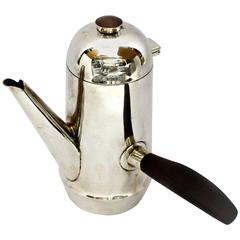Espresso Pot
Recent Sales
Vintage 1960s Mexican Art Deco Coffee and Tea Sets
Sterling Silver
A Close Look at art-deco Jewelry
Fascination with the Jazz Age is endless, and even today jewelry designers continue to be inspired by authentic Art Deco jewelry and watches.
The Art Deco period, encompassing the 1920s and ’30s, ushered in a very distinct look in the design of jewelry. There were many influences on the jewelry of the era that actually began to take shape prior to the 1920s. In 1909, Serge Diaghilev brought the Ballet Russes to Paris, and women went wild for the company’s exotic and vibrant costumes It’s no wonder, then, that jade, lapis lazuli, coral, turquoise and other bright gemstones became all the rage. There already existed a fascination with the East, particularly China and Japan, and motifs consisting of fans and masks started to show up in Art Deco jewelry.
However, the event that had the greatest influence on Deco was the excavation of the tomb of King Tut in 1922. When the world saw what was hidden in Tut’s burial chamber, it sent just about everyone into a frenzy. Pierre Cartier wrote in 1923 that “the discovery of the tomb will bring some sweeping changes in fashion jewelry.” And he couldn’t have been more right. “Egyptomania” left an indelible mark on all of the major jewelry houses, from Cartier to Van Cleef & Arpels, Boucheron and Georges Fouquet. (Cartier created some of the most iconic jewelry designs that defined this era.)
While a lot of Art Deco jewelry was black and white — the black coming from the use of onyx or black enamel and the white from rock crystal and diamonds — there is plenty of color in jewelry of the era. A perfect accent to diamonds in platinum settings were blue sapphires, emeralds and rubies, and these stones were also used in combination with each other.
Many designers employed coral, jade and lapis lazuli, too. In fact, some of the most important avant-garde jewelers of the period, like Jean Després and Jean Fouquet (son of Georges), would combine white gold with ebony and malachite for a jolt of color.
A lot of the jewelry produced during this time nodded to current fashion trends, and women often accessorized their accessories. The cloche hat was often accented with geometric diamond brooches or double-clip brooches. Backless evening dresses looked fabulous with sautoir necklaces, and long pearl necklaces that ended with tassels, popular during the Edwardian period, were favored by women everywhere, including Coco Chanel.
Find unique Art Deco necklaces, earrings, bracelets and other jewelry on 1stDibs.
Finding the Right coffee-tea-sets for You
As a part of your efforts to introduce a calm and tranquil aesthetic to your living room, dining room or other common area, consider how vintage and antique coffee sets and tea sets might play a role in welcoming guests as well as a relaxing atmosphere to your home.
Coffee and tea both have a ritualistic place in history that spans centuries and continents. Some of the oldest tea sets date to the Han dynasty in China. The early tea sets were simple and featured serving bowls rather than teapots. Over time, tea sets and coffee sets evolved to include the variety of pieces that modern sets have today.
Europe became enthralled with tea in the early 1600s when Portuguese and Dutch traders brought it back from China. Around this time, the Ottoman Empire — today’s Turkey — introduced coffee to Europe. In England, tea drinking has been a royal preoccupation for hundreds of years.
It all began in 1662, when Portugal’s Catherine of Braganza brought a canister of tea with her as part of her dowry when she arrived in England to wed King Charles II. During Queen Victoria’s reign, teakettles and coffeepots were added to tea services that were quite large. Indeed, small baked goods were served with your drink back then, and a tea set could include many teacups and saucers, a milk pot and other accessories. Early coffee tables surfaced in Victorian-era England, likely influenced by the use of tea tables in Japanese tea gardens. Since then, tea sets and coffee sets have been created in a range of styles and materials over the years.
Browse 1stDibs for a selection of authentic antique and vintage coffee sets and tea sets, reflecting a time when serving tea and coffee to guests represented the height of class and sophistication. Modern and contemporary designs offer a new take on these enduring objects.
